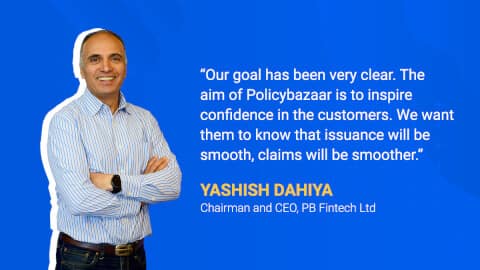1
Feeling Inadequately Insured? 3 Ways To Extend Your Health Insurance CoverLeader Speak
Digital Adoption Has Led The Evolution of Insurance in India: Yashish Dahiya
The insurance industry has evolved rapidly in India over the years. Insurance, which was earlier considered a push product, has now evolved to a pull product in the minds of the consumers. Digital adoption by insurance companies in the last 12 years has only made lives easier for the consumers and led to transparency in the entire ecosystem.
“The biggest thing I learned in the last 12 years is that digital is the most trackable medium. The conversation between the seller and the consumer is being recorded in real-time. So, we have a track record of everything that has been told right from the beginning,” Yashish Dahiya, Group CEO and Co-Founder, Policybazaar said at a webinar organized by CII on Insurance in Covid-19 era.
((relatedarticle_1))
Dahiya said technology is useful in tracing conversations that happened years ago with a consumer to check accurate information during claims. In the physical world, that traceability can not be found. This traceability is critical in the field of insurance, specifically, when it comes to large-value claims on the basis of small-ticket purchases.
IMPROVEMENT IN CLAIM SETTLEMENT JOURNEYS
Gopalan Srinivasan, Director of National Insurance Academy, told PB Life that the industry has progressed a lot in terms of digital adoption over the years.
“Ten years ago, the role of digital was very limited. Today, the insurance industry is distributing policies through web portals. They are also using digital technology for claim settlement processes. Claim payments are being electronically transferred and there are no hassles of preparing cheque and manual handling of claims,” said Srinivasan.
RISING AWARENESS ON THE BACK OF DIGITAL ADOPTION
Digital technology is also being used for connecting to the customers in terms of communications, service, training, and education. “We are seeing digital playing a very important role in all facets of an insurance company’s operations. It is playing an important role in increasing the reach especially in the retail segment of the insurance business,” Srinivasan added.
India is a country with a huge population and diverse geography. He said, “one of the reasons why insurance has not penetrated much in India is the lack of access for the people to reach out to their insurers. That gap is also being filled with digital.”
Insurance websites have also helped in reducing mis-selling significantly. “People are doing research on their own through websites and slowly the number of policies bought online is increasing day by day which is a positive development,” stated experts from the Insurance Institute of India.
In the offline process, at times information is misinterpreted by the consumer but this doesn’t happen online.
((quote_1))
STRENGTHENING OF GRIEVANCE REDRESSAL MECHANISM
An official from the Insurance Institute of India, who did not want to be named, told PBLife that the Insurance Regulator strengthened grievance redressal mechanism digitally in 2010 by introducing the Integrated Grievance Management System (IRGMS).
“IRGMS facilitates online registration of consumer complaints and tracks their status. If the insurance company doesn’t pay heed to your problems, then a consumer can approach the IRDAI,” the official added.
But first, the consumer has to approach the grievance redressal mechanism of the insurance company to lodge their complaint. “The system has the ability to track defined turnaround time for the resolution of the complaints. So, technology is playing an important role in the corporate governance side as well,” they said.
USE OF TECHNOLOGY IN FRAUD MANAGEMENT
Companies are coming with novel approaches like geo-tagging where a customer can send images of the damage or an investigator can click an image of the accident area by geo-tagging it. This increased the authenticity of the image shared with the insurer for claims.
Insurance companies are using data analytics where an algorithm can predict a potential fraud and then an expert can look at it.
“Insurers are using data analytics to detect frauds. The whole backend process which was largely manual is being converted into robotics,” said Srinivasan.
“ Digital underwriting using artificial intelligence and machine learning is being done. Chatbots are in place and call centers are becoming redundant. That way, in every area, companies are moving towards digital,” he added.
(Inputs and editing by: Sunny Lamba)
((newsletter))














